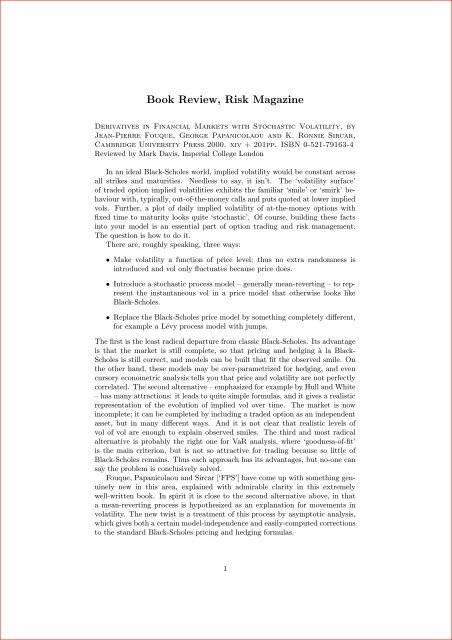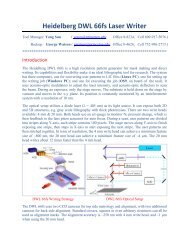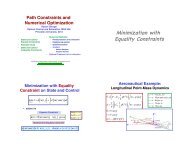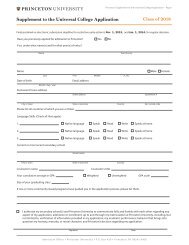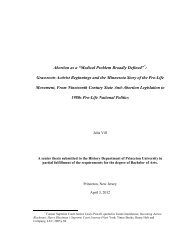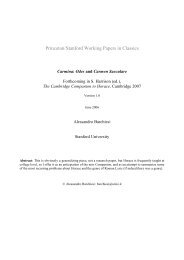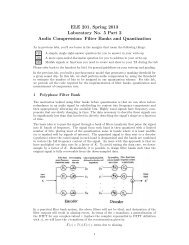By Mark Davis in RISK Magazine - Princeton University
By Mark Davis in RISK Magazine - Princeton University
By Mark Davis in RISK Magazine - Princeton University
Create successful ePaper yourself
Turn your PDF publications into a flip-book with our unique Google optimized e-Paper software.
Book Review, Risk Magaz<strong>in</strong>e<br />
Derivatives <strong>in</strong> F<strong>in</strong>ancial <strong>Mark</strong>ets with Stochastic Volatility, by<br />
Jean-Pierre Fouque, George Papanicolaou and K. Ronnie Sircar,<br />
Cambridge <strong>University</strong> Press 2000. xiv + 201pp. ISBN 0-521-79163-4<br />
Reviewed by <strong>Mark</strong> <strong>Davis</strong>, Imperial College London<br />
In an ideal Black-Scholes world, implied volatility would be constant across<br />
all strikes and maturities. Needless to say, it isn’t. The ‘volatility surface’<br />
of traded option implied volatilities exhibits the familiar ‘smile’ or ‘smirk’ behaviour<br />
with, typically, out-of-the-money calls and puts quoted at lower implied<br />
vols. Further, a plot of daily implied volatility of at-the-money options with<br />
fixed time to maturity looks quite ‘stochastic’. Of course, build<strong>in</strong>g these facts<br />
<strong>in</strong>to your model is an essential part of option trad<strong>in</strong>g and risk management.<br />
The question is how to do it.<br />
There are, roughly speak<strong>in</strong>g, three ways:<br />
• Make volatility a function of price level; thus no extra randomness is<br />
<strong>in</strong>troduced and vol only fluctuates because price does.<br />
• Introduce a stochastic process model – generally mean-revert<strong>in</strong>g – to represent<br />
the <strong>in</strong>stantaneous vol <strong>in</strong> a price model that otherwise looks like<br />
Black-Scholes.<br />
• Replace the Black-Scholes price model by someth<strong>in</strong>g completely different,<br />
for example a Lévy process model with jumps.<br />
The first is the least radical departure from classic Black-Scholes. Its advantage<br />
is that the market is still complete, so that pric<strong>in</strong>g and hedg<strong>in</strong>g à la Black-<br />
Scholes is still correct, and models can be built that fit the observed smile. On<br />
the other hand, these models may be over-parametrized for hedg<strong>in</strong>g, and even<br />
cursory econometric analysis tells you that price and volatility are not perfectly<br />
correlated. The second alternative – emphasized for example by Hull and White<br />
– has many attractions: it leads to quite simple formulas, and it gives a realistic<br />
representation of the evolution of implied vol over time. The market is now<br />
<strong>in</strong>complete; it can be completed by <strong>in</strong>clud<strong>in</strong>g a traded option as an <strong>in</strong>dependent<br />
asset, but <strong>in</strong> many different ways. And it is not clear that realistic levels of<br />
vol of vol are enough to expla<strong>in</strong> observed smiles. The third and most radical<br />
alternative is probably the right one for VaR analysis, where ‘goodness-of-fit’<br />
is the ma<strong>in</strong> criterion, but is not so attractive for trad<strong>in</strong>g because so little of<br />
Black-Scholes rema<strong>in</strong>s. Thus each approach has its advantages, but no-one can<br />
say the problem is conclusively solved.<br />
Fouque, Papanicolaou and Sircar [‘FPS’] have come up with someth<strong>in</strong>g genu<strong>in</strong>ely<br />
new <strong>in</strong> this area, expla<strong>in</strong>ed with admirable clarity <strong>in</strong> this extremely<br />
well-written book. In spirit it is close to the second alternative above, <strong>in</strong> that<br />
a mean-revert<strong>in</strong>g process is hypothesized as an explanation for movements <strong>in</strong><br />
volatility. The new twist is a treatment of this process by asymptotic analysis,<br />
which gives both a certa<strong>in</strong> model-<strong>in</strong>dependence and easily-computed corrections<br />
to the standard Black-Scholes pric<strong>in</strong>g and hedg<strong>in</strong>g formulas.<br />
1
They start with the Ornste<strong>in</strong>-Uhlenbeck process, a mean-revert<strong>in</strong>g Gaussian<br />
process Y t satisfy<strong>in</strong>g the SDE<br />
dY t = α(m − Y t )dt + βdW t , (1)<br />
where W t is Brownian motion. This is an asymptotically stationary process,<br />
whose stationary distribution is N(m, β 2 /2α) (the normal distribution with<br />
mean m and variance b 2 /2a, density function φ(y).) Further, it is ergodic,<br />
<strong>in</strong> that ‘time average = ensemble average’. This means that if we take a (say<br />
bounded) function f then<br />
∫<br />
1 T<br />
∫<br />
f(Y t )dt →<br />
T 0<br />
f(y)φ(y)dy as T → ∞ (2)<br />
The parameter α controls the speed of convergence to the stationary distribution.<br />
Indeed, <strong>in</strong>creas<strong>in</strong>g α is equivalent to speed<strong>in</strong>g up the process, so if we<br />
<strong>in</strong>crease α while keep<strong>in</strong>g the stationary variance β 2 /2α constant then the <strong>in</strong>tegral<br />
on the left of (2) keep<strong>in</strong>g T fixed will converge to the average on the<br />
right. Suppose we now let σ 2 (t) = f(Y t ) be the stochastic volatility <strong>in</strong> our<br />
price model. Then the <strong>in</strong>tegral on the left of (2) is just the average realized<br />
variance over the <strong>in</strong>terval [0,T]. If α is very large this is effectively constant,<br />
and we are back to Black-Scholes. The central argument of FPS is that <strong>in</strong> reality<br />
α is large but not <strong>in</strong>f<strong>in</strong>itely large, so we can treat the stochastic volatility<br />
model as a small perturbation from Black-Scholes, which can be quantified by<br />
an asymptotic expansion.<br />
The bottom l<strong>in</strong>e is a corrected pric<strong>in</strong>g formula giv<strong>in</strong>g the option price P as<br />
P = P 0 − P 1 where P 0 is the Black-Scholes price based on long-run average<br />
volatility and the correction P 1 is given by<br />
(<br />
)<br />
(T − t) V 2 x 2 P (2)<br />
0 + V 3 x 3 P (3)<br />
0 .<br />
Here P (2)<br />
0 , P (3)<br />
0 are the second and third derivatives with respect to price (so<br />
P (2)<br />
0 is the option gamma). This is <strong>in</strong>itially derived from the stochastic vol<br />
model (1), but the authors po<strong>in</strong>t out that the formula is universal <strong>in</strong> that a<br />
wide range of vol models lead to exactly the same formula, albeit with different<br />
V 2 , V 3 . These parameters can be used to calibrate the model to a given implied<br />
volatility surface by a simple procedure. There is also an associated hedg<strong>in</strong>g<br />
strategy based, roughly speak<strong>in</strong>g, on delta hedg<strong>in</strong>g with the corrected price. As<br />
FPS po<strong>in</strong>t out this hedg<strong>in</strong>g strategy is not self-f<strong>in</strong>anc<strong>in</strong>g, but it is a ‘m<strong>in</strong>imum<br />
variance’ strategy. Applications to exotic options and to <strong>in</strong>terest rate cont<strong>in</strong>gent<br />
claims are also developed.<br />
Have FPS cracked the stochastic volatility problem? Not really, but they<br />
have certa<strong>in</strong>ly provided an <strong>in</strong>novative approach that merits attention and complements<br />
the methods listed above. The approach is applicable to pric<strong>in</strong>g and<br />
hedg<strong>in</strong>g but not to VaR analysis. Pric<strong>in</strong>g is relatively benign <strong>in</strong> that the calibration<br />
process tends to wash out the differences between models except <strong>in</strong><br />
the case of really sensitive exotics. In hedg<strong>in</strong>g, it is very hard to establish that<br />
any method of volatility prediction is consistently superior <strong>in</strong> terms of portfolio<br />
hedge performance us<strong>in</strong>g historical price and implied vol data. It rema<strong>in</strong>s to be<br />
seen how the FPS method stacks up <strong>in</strong> this respect.<br />
2
As a prelude to their ma<strong>in</strong> theme, FPS have provided a compact but very<br />
readable summary of a number of topics <strong>in</strong> mathematical f<strong>in</strong>ance, stochastic<br />
analysis and <strong>Mark</strong>ov processes, putt<strong>in</strong>g a welcome emphasis on the effects of<br />
model error <strong>in</strong> dynamic hedg<strong>in</strong>g. F<strong>in</strong>ally, the book is short and to the po<strong>in</strong>t,<br />
and the production quality is high. Buy it.<br />
3


